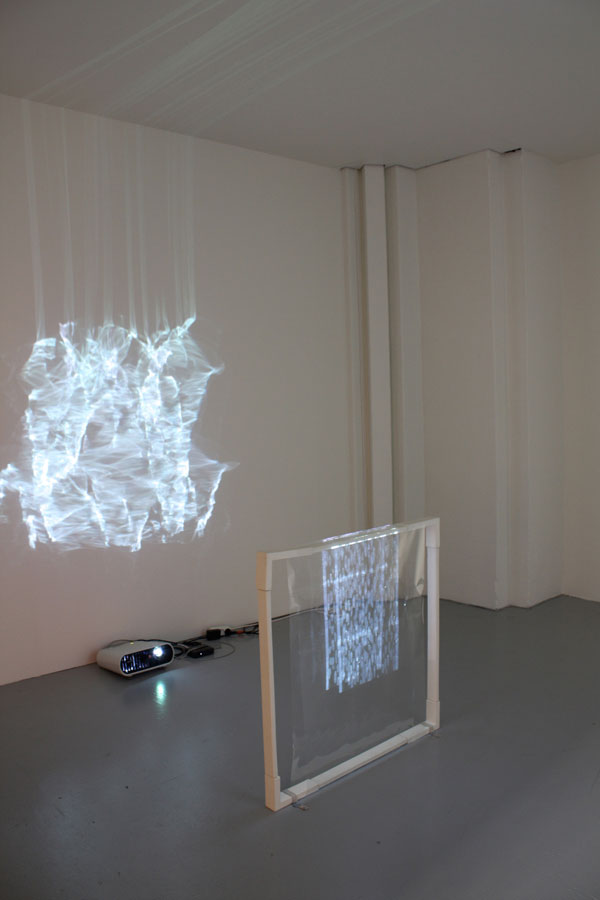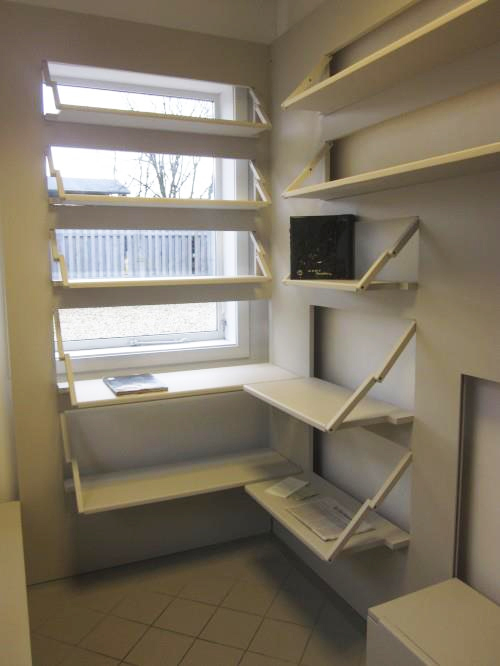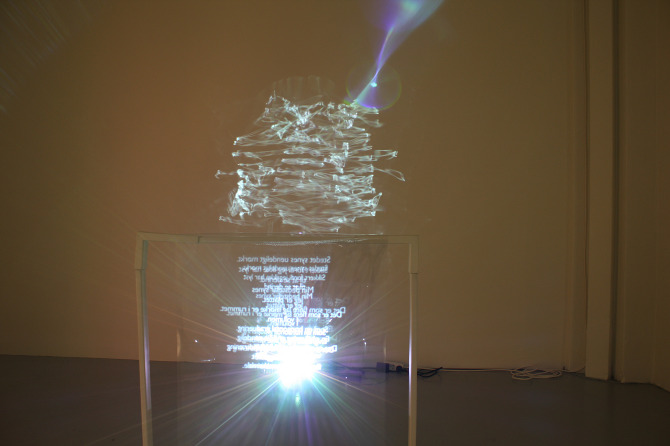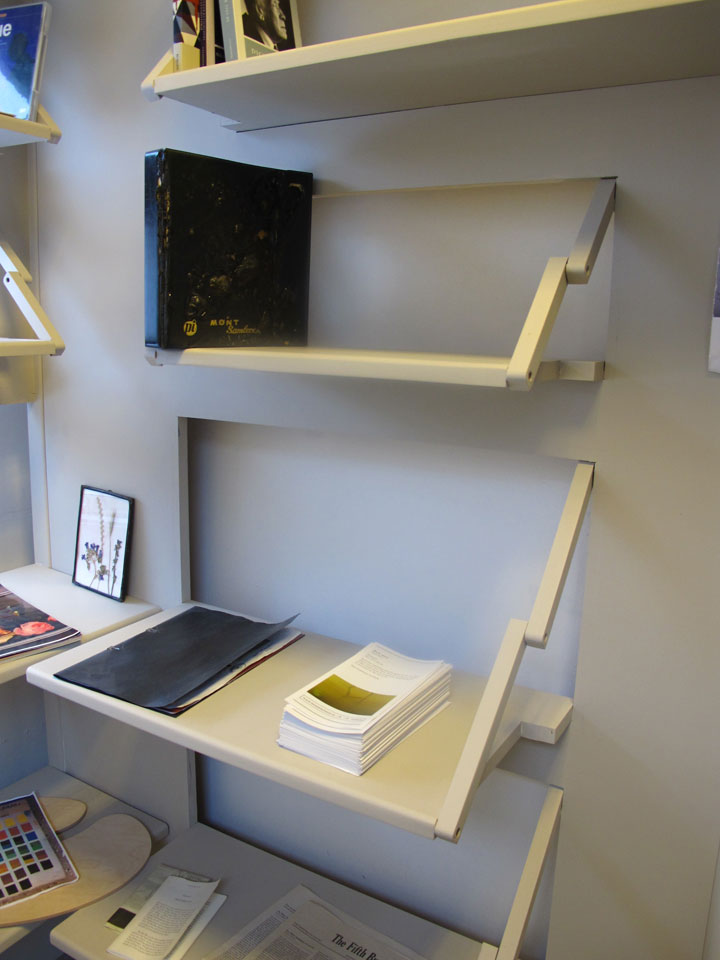
Johanne Dybdal Sigvardsen, Ravkammer / Amber Chamber (installation view at Kunsthallen Nikolaj, Copenhagen), 2012. MPEG-file, porcelain, leather, film, tape, projector, and media player, 11 minute loop, dimensions variable. Image courtesy of the artist.
I was on the verge of tapping the send button on an email with the subject line “Congratulations, you have been accepted into The Drawing Center’s Viewing Program” to Johanne Dybdal Sigvardsen, a new VP artist. I then glanced at her bio and realized that she was from Copenhagen, Denmark. I attached a few personal sentences to the official Viewing Program acceptance email to introduce myself and offer to meet Johanne in Copenhagen, where I was scheduled to speak at the Danish Royal Academy a month later. I was curious about her approach to drawing, which among other methods incorporates light projections. She responded to my email almost immediately and was delighted to have a studio visit. It turns out Johanne’s studio is situated in an artist-run project named Antechamber, which is coincidentally focused on drawing and research. The space was conceived by Norwegian artist Jeanette Sætre and Swedish artist Hilda Ekeroth in January 2012.
Johanne and I met at the Academy and then traveled on the metro four stops out from city center to her studio at Antechamber, a nondescript, one-story industrial building. We met Hilda Ekeroth there, one of the founding artists. Over hot beverages and chocolate we huddled in the drafty studio/exhibition space, talking about drawing and the unique platform that Antechamber offers to artists in Copenhagen. Besides being one of a few artist-initiated exhibition spaces there, Antechamber fills a gap in its approach to drawing and research by thinking about conceptual practices both historically and reinterpreted in the present.

Andreas Bertilsson, Shelving unit installed at Antechamber, Copenhagen. Image courtesy of Antechamber.
Hilda pointed to the shelving unit in the entrance of the space as an example of drawing that she finds exciting. The shelves were designed by Andreas Bertilsson, an artist and musician. The unit fits the dimensions of the entrance perfectly, spanning two walls and framing a window. The design is economical; shelves, a bench, and a chair hinge from the large plywood planes. The beauty of the piece according to Hilda is in its spare measure and non-functioning parts: the bench and chair are too fragile to use, and the hinged shelves chafe away at the paint when collapsed. The shelves are an experimental drawing that frames real space, holding essential books, ideas, and an archive of past exhibitions.
I asked Hilda and Johanne if Antechamber had affected their work or thinking. They both spoke enthusiastically about working in a studio that is both public and private. Every second month an exhibition or performance is scheduled. In between, the project space becomes a working studio again. They described the feeling of their studios absorbing the marks and thoughts of other artists and how this challenged and added to their thinking.
Johanne’s work experiments with materials and textures that have a resonance from her childhood: off-white wallpaper embossed with designs, an amber brooch, bronze filters that were used by her father (a geographer), graphite, and glass. I was most curious about a recent installation she made at Krognoshuset in Lund, Sweden titled Ravkammer /Amber Chamber. The title comes from a palace outside of St. Petersburg called the Catherine Palace, which was known for a magnificent Amber Room. The palace was a gift from Germany to the Russian tsar in 1716. During the German occupation in 1941, the Amber Room was dismantled and sent to Köningsberg, and it was never seen again. No one knows where the amber panels are—most likely they were destroyed when Köningsberg was firebombed in 1944.
Johanne’s installation Ravkammer/ Amber Chamber makes reference to the lost Amber Room through writing. The Amber Room becomes a sensual channel for the artist’s memories of her childhood home. Her writing is printed on a clear film and overlapped with another film depicting a delicate drawing of chamber-like patterns. The two surfaces and the projected light create irregular reflections on the walls and dissolve the solid interior of the room; walls waver as if the viewer is underwater. Johanne said, “I think it’s essential to reshape or find and unfold potentials in already established rooms and structures.”

Johanne Dybdal Sigvardsen, Ravkammer / Amber Chamber (installation view at Kunsthallen Nikolaj, Copenhagen), 2012. MPEG-file, porcelain, leather, film, tape, projector, and media player, 11 minute loop, dimensions variable. Image courtesy of the artist.
I left excited to think about possible ways that the Viewing Program could host exhibitions or share programs in spaces like Antechamber that are emerging in cities around the world. How could the Viewing Program become a resource that connects artists and their work inside and outside of The Drawing Center?
–Lisa Sigal, Viewing Program Curator

